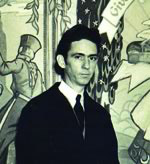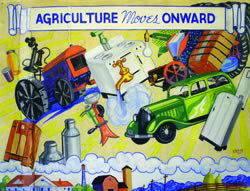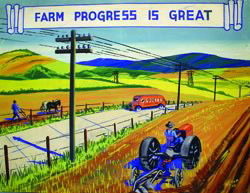Depression Era Paintings Capture History of Alabama Agriculture
By: Maggie Lawrence

The artist and his work–
John Augustus Walker.
A visitor to the Special Collections room of the Ralph Brown Draughon Library will encounter numerous artifacts of by-gone eras. Perhaps some of the most unusual are a collection of 10 large canvases depicting Alabama agriculture, beginning with the American Indians.
In early 1939, P.O. Davis, director of the Alabama Cooperative Extension Service, along with Luther Duncan, president of Alabama Polytechnic Institute, and Warren Leach, head of the Alabama State Fair Commission, conceived a plan to highlight the importance of agriculture. The project was planned for the state fair to be held in Birmingham that October.
The three envisioned a series of giant paintings representing Alabama agriculture from its earliest beginnings to the modern agricultural industry of the 1930s.
To find a suitable painter Davis turned to the Federal Arts Project, a division of President Franklin Roosevelt's Works Progress Administration.
Alabama Cooperative Extension System art specialist Bruce Dupree says Auburn's first desire was to hire an Alabama artist to do the work—a challenge during the hard times of the ongoing depression.
"John Augustus Walker, a Mobile native, was chosen to execute the ideas in a mural form," says Dupree. "The murals were to be displayed in one of the exhibit halls at the 1939 fair."
He adds that Walker, who helped found the Mobile Art Guild, is known not only for his paintings and murals—found both in private collections and public buildings across Alabama and the Gulf Coast—but also for his work designing Mardi Gras floats and costumes.
Walker, who studied at the St. Louis School of Fine Arts, created the API murals not in his preferred medium of oil paints but rather in tempera, a water-based medium. The 7- by 8-foot paintings are done on unprimed canvases attached to wooden stretchers.


Two of the murals he painted during the Depression.
"I think that's an indication that he really viewed these paintings as transient—to be displayed at the state fair only," says Dupree. "I think he would be surprised to know that they have survived almost 70 years."
How the paintings traveled to Auburn after the fair remains a mystery. They were discovered in 1980 by Georgia Aycock, an Extension specialist, who had an office in Duncan Hall, which houses the Extension System's Auburn headquarters.
"Georgia was searching for something in the Duncan Hall attic and flipped back a tarp to find these paintings," he says.
The paintings were exhibited in Foy Union after this discovery. They were returned to the Duncan Hall attic for a number of years and were later transferred to Special Collections.
"It's a shame that these paintings are tucked away where so few can see them," says Dupree. "Not only are they a visual record of farming in Alabama, but they are an example of the work done by artists with the WPA." He notes that WPA artwork included framed paintings, murals and sculptures.
"We have lost so many of these pieces over the years. It's important that we preserve this group of WPA works that have such a strong association with Extension and Auburn University. The paintings are not in the best condition, and it would be wonderful to see them restored and housed where they could be displayed on a regular basis."
Extension will host an opening reception at 4:00 p.m. Sept. 21. W. Gaines Smith, Extension interim director, will speak and Dupree will discuss the artist and the paintings. On Sept. 23, Walker's son, John Walker, will join Smith and Dupree to talk with visitors and fans before the Auburn/University of Buffalo football game.
As part of the University's Sesquicentennial celebrations, Extension is hosting an exhibition of Walker's paintings in the Foy Union Gallery Sept. 21-23.
